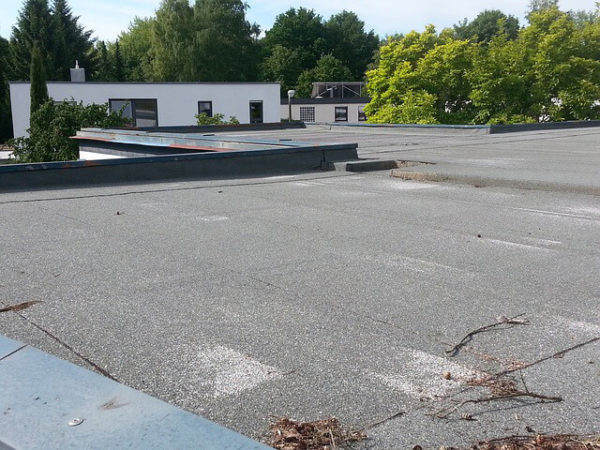Is Rubber Roofing Better Than Felt?
For many years, bitumen felt was one of the most popular types of flat roof available, but in recent years, other types of material, such as EPDM rubber roofing, have brought something different to the market. These advanced roofing systems have changed the look and function of flat roofing in the UK industry.
But is rubber flat roofing worth it? And is rubber better than felt? In this blog, we cover everything from rubber roof cost considerations to how to felt a flat roof.

What Is Rubber Roofing?
Rubber roofing is often referred to as EPDM, which stands for Ethylene Propylene Diene Monomer. Essentially, it’s a synthetic rubber material that’s used across multiple industries in many different applications, thanks to how easily it conforms to what you need it to do. This includes creating an impermeable seal, as well as forming an insulating membrane across surfaces. That’s why it’s the most popular of all the available rubber flat roofing systems.
Is Felt Still Used for Roofing?
Yes! Older flat roofs often tend to suffer if the felt was installed many years ago, often facing tears and rips which could leave properties vulnerable to issues such as damp and leaks. The modern bitumen chosen for felt roofs these days may include small metal fibres, increasing its strength and weatherproofing abilities.
The improvements made to the way felt roofing is manufactured and installed have led to fewer problems. While most types of felt roof will only offer guarantees of up to 10 years, it may be up to 20 before you need to consider a replacement.
Bitumen vs EPDM – Which Type of Roofing Is Better?
Felt is still one of the most cost-effective flat roofing solutions available, but while there’s no doubt it has come a long way since the 90s, you should always explore the different options available to you when installing or upgrading a roof. Many homeowners would prefer to invest in roofing materials that last for as long as possible, budget allowing.
Rubber roofing like EPDM is considered a far superior product than traditional felt, thanks to the wide range of benefits on offer. It’s one of the best quality flat roofing materials and is incredibly easy to install. The outcome is a strong, waterproof and durable system that won’t experience tearing or blistering. It will often come with a guarantee of 20 years, but will last for up to 50, so you may only need to install it once in your lifetime.
On the flip side, EPDM is often a more premium choice (although still cheaper than GRP fibreglass). If felt is going to fit your budget better, as long as you choose an experienced roofing company, they should be able to help you select a quality bitumen roof.
When Should You Use a Rubber Roof?
A rubber flat roof is best applied to low-sloped shapes where traditional tiles may not perform so well at draining rainwater effectively. It’s a good option for outbuildings, like sheds, garden offices, carports and garages, as well as porches and extensions.
Flat rubber roofing is also used for commercial and industrial buildings with expansive flat roofs. That’s because rubberised roofing can be conveniently applied in large sheets for wide, uninterrupted spaces.
How Much Does EPDM Rubber Roofing Cost?
So, how much does rubber roofing cost? When considering a rubber roofing material, the price will always vary depending on the size of the area to cover, the installation method and how complex the task is. Many roofers will charge per square metre for a professionally fitted EPDM system. Large and more complex roofs will require more adhesives, insulation and additional layers.
In comparison, felting a flat roof is generally cheaper because the materials are less expensive and more widely available. It’s also faster to apply, making upfront costs lower. However, property owners should always consider the expected life expectancy of each material and the maintenance involved, rather than automatically going for the most budget-friendly option.
The Installation Process – EPDM vs Felt
The way each flat roof system is installed is another factor to consider. EPDM rubber roofs are typically supplied in large, single sheets that are rolled out and cut to size to fit your roof exactly. This reduces the number of seams involved, which are usually the weakest points of a roof for water ingress.
And what about how to felt flat roof systems? Well, felt roofs are usually applied in layers, which also needs to be completed by an experienced installer. The speed at which installations happen will always depend on the experience of your roofer and the complexity of the task.
How Long Will Rubber Roofs Last?
As well as EPDM roofing cost considerations, how long rubber flat roofs last is important to understand when choosing a material for your property. EPDM is an excellent long-term investment, particularly for flat and low-slope roofs where other materials may fail sooner.
EPDM rubber roofs have impressive longevity, often lasting for 40 to 50 years if the system is properly installed and well-maintained. That’s due to the wide range of benefits we’ve already discussed, such as resistance to cracking, UV damage and fluctuations in temperature, maintaining rubber’s integrity for decades.
In addition, if rubber roofing does sustain any damage (like small punctures), it can usually be repaired quickly without the need to replace the entire roof, extending the material’s life even further. However, once installed, rubber roofs need very little attention after installation, saving you time and money.
Looking for a New Flat Roof?
At Collier Roofing, we offer a wide range of roofing solutions to our customers in Surrey, London and surrounding areas. This includes high-quality felt for flat roof systems and rubber roofs in Godstone, Lingfield and Whyteleafe.
If you would more information or advice about our services, contact us today.
